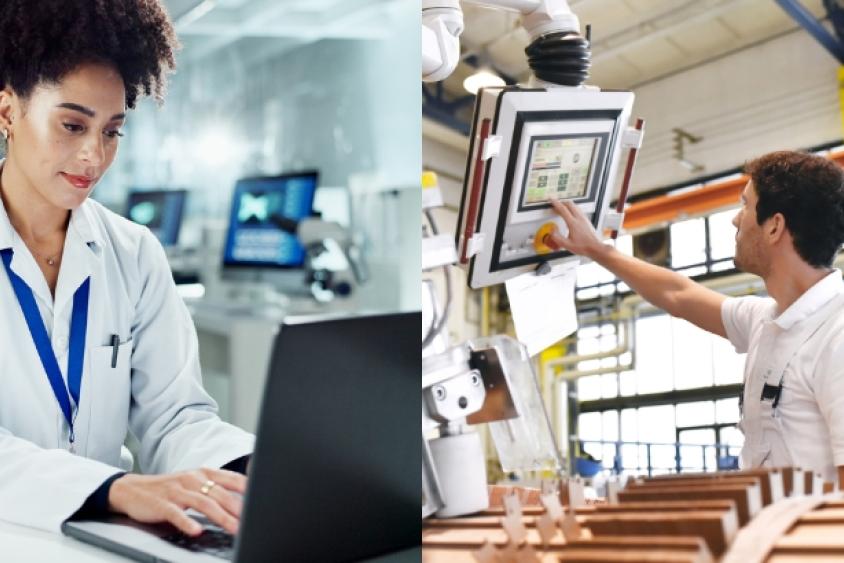How Healthcare and Manufacturing Drive Innovation Through Imaging Technologies

Though they seemingly operate in distinct domains—healthcare and manufacturing share a surprising intersection: imaging technologies. Dr. Brian Anthony, Director of MIT’s Master of Engineering in Manufacturing Program and lead instructor of the MIT Professional Education course, Imaging Systems & Machine Learning in Medicine and Advanced Manufacturing, explains how experts from these two industries can share insights with each other to unlock new levels of innovation and efficiency.
Q: How can imaging technologies bridge the gap between medical and manufacturing industries, and what specific benefits can arise from this collaboration?
Dr. Anthony: Imaging technology offers significant common ground for medical and manufacturing sectors. For example, CT scans, a staple in medical diagnostics, create cross-sectional images by rotating an X-ray beam around a patient or object. Manufacturers can similarly utilize these methods for non-destructive product inspections, particularly beneficial for detecting defects in castings and complex assemblies. This shared use of imaging technology can substantially reduce waste, boost quality control, and spur innovation by exchanging techniques and insights across disciplines.
Q: Factories provide controlled environments ideal for precise imaging. How can medical settings leverage these principles despite their inherent variability?
Dr. Anthony: Manufacturing environments are optimized for precision imaging due to their controlled conditions. For example, factories can paint a wall a certain color to provide maximum contrast between the product and its surrounding environment. In healthcare settings, variability and patient movement pose challenges, making it difficult to produce precise or repeatable images. However, medical imaging can significantly enhance precision by incorporating additional sensors to track movement, pressure, or other environmental factors. Such integration allows healthcare professionals to achieve more reliable, consistent results even within less predictable environments, ultimately improving diagnostic accuracy and patient outcomes.
Q: Motion capture is extensively used in physical therapy. How can this technology also benefit the manufacturing sector?
Dr. Anthony: In physical therapy, motion capture is instrumental in diagnosing and tracking musculoskeletal conditions, allowing clinicians to analyze patient mobility objectively. Similarly, manufacturing industries can apply motion-capture technology to proactively identify ergonomic risks, optimize workflows, and enhance worker safety. By streamlining worker movements and reducing ergonomic hazards, manufacturers can significantly improve productivity and reduce workplace injuries.
Q: What is photoacoustic imaging, and how can it apply across both medicine and manufacturing?
Dr. Anthony: Photoacoustic imaging involves using pulsed laser beams to generate and detect sound waves, allowing for imaging without physical contact. In medicine, it provides a non-invasive, contact-free imaging option to see inside the body with the benefits of ultrasound, which can be advantageous for sensitive or challenging diagnostic scenarios. In manufacturing, this contactless imaging method enables precise inspection of materials such as aluminum and steel, enhancing quality control processes by uncovering defects otherwise difficult to detect with traditional methods.
Q: Why is cross-industry collaboration essential for innovation, and what role should professionals play to foster this interaction?
Dr. Anthony: Significant breakthroughs often occur at the intersection of diverse fields. By actively pursuing cross-industry collaboration, professionals in both medical and manufacturing sectors can leverage unique insights and methodologies to drive innovation. Professionals must step beyond their familiar roles, actively engaging in interdisciplinary dialogue and collaboration. This openness to learning and partnership is crucial for advancing imaging technologies, enhancing healthcare diagnostics, and optimizing manufacturing processes. The future of imaging — whether for diagnosing diseases or optimizing manufacturing processes — may depend not just on technological advancements but on the willingness of professionals to learn from one another.
Dr. Anthony is the director of MIT’s Master of Engineering in Manufacturing Program, co-director of the Medical Electronic Device Realization Center, and associate director at MIT.nano. He is also the lead instructor of the MIT Professional Education course, Imaging Systems & Machine Learning in Medicine and Advanced Manufacturing. With over 20 years of experience in product realization — Dr. Anthony won an Emmy (from the Academy of Television Arts and Sciences) in broadcast technical innovation — Dr. Anthony designs instruments and techniques to monitor and control physical systems. His work involves systems analysis and design and calling upon mechanical, electrical, and optical engineering, along with computer science and optimization, to create solutions.
Source: MassTLC


